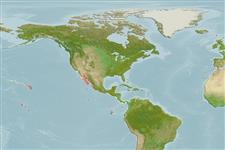>
Blenniiformes (Blennies) >
Labrisomidae (Labrisomids)
Etymology: Malacoctenus: Greek, malakos = soft + Greek, kteis, ktenos = comb (Ref. 45335).
Eponymy: Dr Clark Hubbs (1921–2008) was an ichthyologist and biologist who followed in his father’s footsteps (see Carl Levitt Hubbs, below). [...] (Ref. 128868), visit book page.
Environment: milieu / climate zone / depth range / distribution range
Écologie
marin démersal; profondeur 1 - 4 m (Ref. 11482). Tropical
Eastern Central Pacific: Gulf of California and southwestern coast of Baja California.
Taille / Poids / Âge
Maturity: Lm ? range ? - ? cm
Max length : 9.0 cm TL mâle / non sexé; (Ref. 11482)
Description synthétique
Clés d'identification | Morphologie | Morphométrie
Malacoctenus hubbsi differs from Malacoctenus polyporosus by the following characters: symphysial pores 1-3, usually 1 or 3 (vs. 2-10 usually 5-7); lateral line scales 51-61, usually 54-58 (vs. 49-56, usually 50-53); and by the number of anal-fin rays (Ref. 82814).
Occurs in shallow rocky areas. Feeds on invertebrates.
Life cycle and mating behavior
Maturité | Reproduction | Frai | Œufs | Fécondité | Larves
Allen, G.R. and D.R. Robertson, 1994. Fishes of the tropical eastern Pacific. University of Hawaii Press, Honolulu. 332 p. (Ref. 11482)
Statut dans la liste rouge de l'IUCN (Ref. 130435: Version 2024-1)
Menace pour l'homme
Harmless
Utilisations par l'homme
Outils
Articles particuliers
Télécharger en XML
Sources Internet
Estimates based on models
Preferred temperature (Ref.
123201): 22.3 - 28.5, mean 24.4 °C (based on 123 cells).
Phylogenetic diversity index (Ref.
82804): PD
50 = 0.5000 [Uniqueness, from 0.5 = low to 2.0 = high].
Bayesian length-weight: a=0.00955 (0.00474 - 0.01922), b=3.10 (2.93 - 3.27), in cm total length, based on LWR estimates for this species & (Sub)family-body (Ref.
93245).
Niveau trophique (Ref.
69278): 3.5 ±0.37 se; based on food items.
Fishing Vulnerability (Ref.
59153): Low vulnerability (10 of 100).
Nutrients (Ref.
124155): Calcium = 363 [197, 826] mg/100g; Iron = 1.52 [0.91, 2.81] mg/100g; Protein = 18.1 [17.1, 19.1] %; Omega3 = 0.216 [0.114, 0.400] g/100g; Selenium = 22.4 [10.7, 50.9] μg/100g; VitaminA = 50.9 [15.5, 163.4] μg/100g; Zinc = 2.19 [1.49, 3.32] mg/100g (wet weight);
